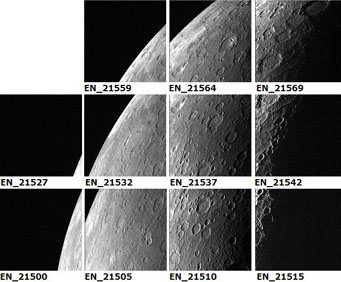I'm in Houston, Texas, this week for the annual Lunar and Planetary Science Conference. Researchers first started gathering here in the late 1960s to discuss what they've learned from the Apollo missions. Since then the meeting has grown enormously, to roughly 2,000 attendees from all over the world. I'll have my hands full trying to glean all the exciting new discoveries that'll be presented.

As NASA's Messenger spacecraft approached Mercury on January 14, 2008, its camera took dozens of images to capture details on a portion of the planet unseen by Mariner 10 during the 1970s. Click here to see all the segments of the full mosaic.
Kelly Beatty
This year's highlight wasn't Moon rocks (though moonwalkers John Young and Harrison "Jack" Schmitt were in the audience) but rather what the Messenger spacecraft has taught us about mysterious Mercury.
There were 23 presentations about the craft's January 14th flyby yesterday — and although nothing particularly astounding came out of those, it's impressive to see what can be gleaned about a planet from one quick visit. In the parlance of mission controllers, Messenger's flyby was completely "nominal." All of its experiments worked well, delivering 1,213 images and about 500 megabytes of data in total to waiting scientists.
One much-anticipated result didn't involve an instrument at all. The spacecraft sped up and slowed down by 1.3 km per second as it passed the planet, and by tracking its velocity to an accuracy of about 1 centimeter per second, it's possible to map the planet's gravity field and deduce what's inside.
David Smith (NASA/Goddard Space Flight Center) reported that the craft experienced a larger perturbation than expected, and the only way he can make sense of the results is if some large concentration of mass lies hidden beneath the surface somewhere along the flyby track. Such "gravity anomalies" are pretty common on the Moon, especially under the mare basins. Smith figures Mercury's must be somewhere near 15° south, 58° east, a location hidden in darkness during the flyby.
A second revelation came from Messenger's laser altimeter, which bounces rapid-fire pulses of laser light off the planet and carefully times their round-trip times to determine surface elevations. The good news, says team leader Maria Zuber (MIT) isn't anything that the altimeter revealed in particular — it's that the instrument worked far better than expected. It was able to pick up reflections not only from directly below the spacecraft but also from up to 70° off to the side — and at ranges of more than 1,500 km (1,000 miles). This is important, because it means that once Messenger finally settles into orbit three years from now, the altimeter will be able to "see" into the permanently shadowed craters at Mercury's poles, which are thought to contain trapped water ice.
Finally, Jim Head (Brown University) addressed the enigmatic "smooth plains" that cover pretty much everywhere on Mercury that isn't a crater. After Mariner 10 flew past the planet in the mid-1970s, geologists couldn't agree whether these smooth areas were caused by widespread volcanic eruptions (as has occurred on Venus) or by blankets of debris dumped across the landscape by a series of enormous impacts. On closer inspection, Head says, the plains appear to be lava flows. But they're all quite ancient — he sees no evidence (yet) that Mercury is volcanically active today.
Color-wise, Mercury is pretty bland, though the team has found some pink- and orange-tinged areas that look tantalizing. I was hoping to hear more about the composition of Mercury, and in particular whether the surface chemistry offers any hints as to why this planet is so dense and iron rich. (Curiously, there's very little iron on the surface of Mercury itself.) But if the mission's geochemists know the answer, they were mum yesterday. Chances are we'll hear more when they publish the complete flyby wrap-up in a forthcoming issue of Science magazine.
 0
0
Comments
You must be logged in to post a comment.